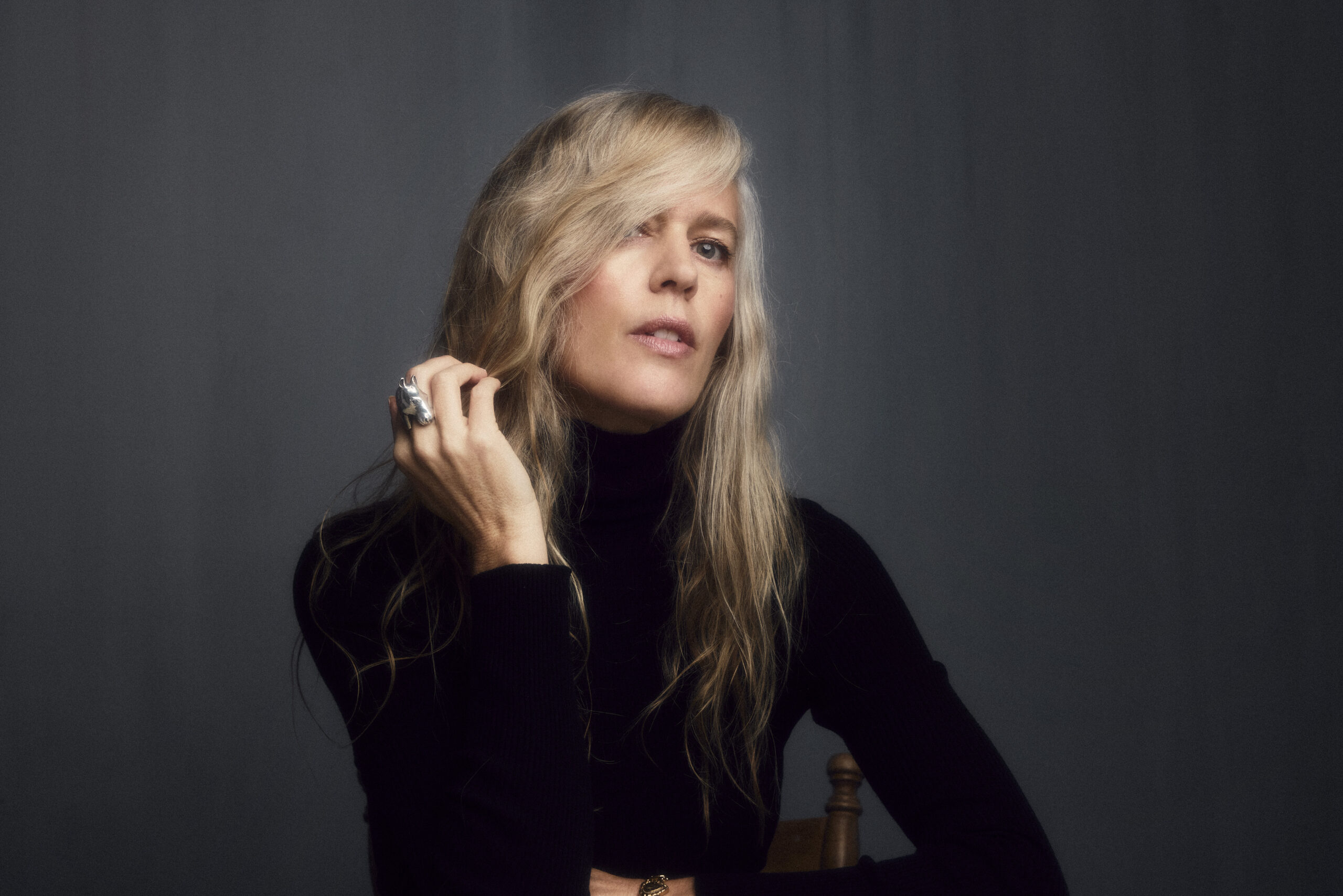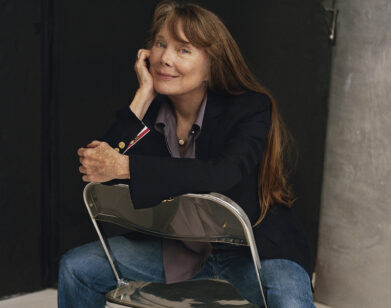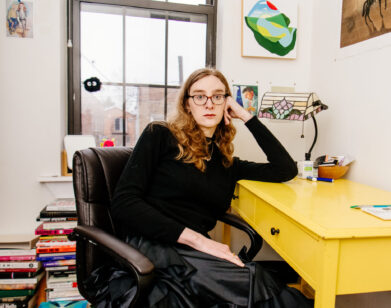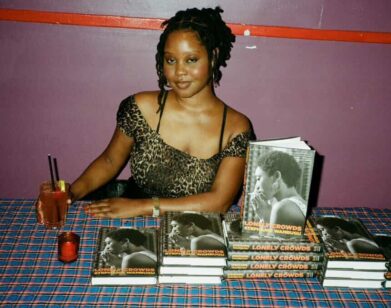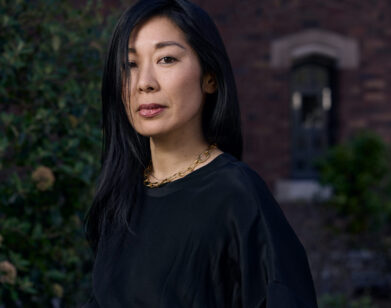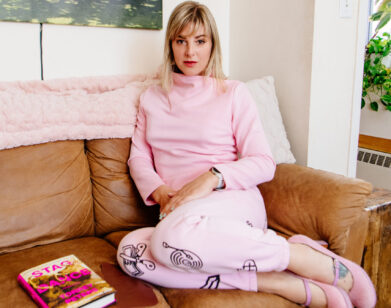LIT
“I Wanted Only Velocity”: Claudia Dey on Her Provocative Novel, Daughter
Claudia Dey is a rare force—luminous yet adamantine. Attending the Toronto launch of Dey’s novel, Daughter, my friend and plus-one, who hadn’t yet seen an image of the author, pointed towards a woman with silvery-blond hair, red nails, and a preternatural glow. “Who is that?” he asked, impressed. “That’s Claudia Dey,” I said.
Riding the high of a recent New York Times rave for Daughter, Dey’s star is on the rise in Toronto and beyond. Reading the novel’s ravenous, clear-eyed prose, one can understand why. Dey’s writing feels akin to jumping into an alpine lake. For a few seconds, you’re in shock—and then suddenly, you’re overwhelmed with sensation, hyperconscious of your own aliveness and its perverse proximity to numb unfeeling. The immediacy is unnerving, addictive, almost frightening. Yet the intensity of Daughter’s voice is grounded by its protagonist’s realness: in the book, Mona, a young woman playwright, navigates a complex relationship with her father, a supposed literary genius, who plays an equal parts intoxicating and toxic role in Mona’s life, engaging his daughter as a confidante then scapegoating her to repair his relationship with his second wife.
Last month, before Daughter hit bookshelves, Dey and I spoke over Zoom. I wanted to know more about how she accessed Mona’s world, the overlap with Dey’s own theatre background and creative upbringing, and what Dey’s version of creative calm looks like (spoiler alert: she’s entirely uninterested in relaxing).
———
CLAUDIA DEY: Hello.
ESMÉ HOGEVEEN: How are you?
DEY: I’m good. How are you?
HOGEVEEN: Good. I recognize your backdrop from Instagram.
DEY: Yeah, this is my study.
HOGEVEEN: Are you in Toronto right now?
DEY: Mm-hmm.
HOGEVEEN: Where are you at in the press cycle? I sense you’ve been taking part in conversations this week.
DEY: Yeah, it’s busy. It’s the strangest job, because you’re a monk for like three years and then suddenly you have to look at what you’ve produced in this completely different way where it needs to become this communicable thing, which is super interesting. I’ve had amazing conversations with people. So I like this part.
HOGEVEEN: It’s September, the back to school agenda.
DEY: Oh my god. I can feel it at night. I can feel September at night.
HOGEVEEN: Do you like that feeling?
DEY: I like the change in the temperature. Although I have a little bit of melancholia thinking about summer fading into the distance again.
HOGEVEEN: In July, we were saying people either become angry or perverts.
DEY: Oh my gosh. That’s so good. Do you remember that play, which was turned into a film, where Sissy Spacek murders her husband and then makes a pitcher of lemonade? It was called Crimes of the Heart. That’s anger and perversion, but also very July.
HOGEVEEN: I wanted to throw back to you a quote of yours. You said, “I often think of writing as the invisible profession.” Since Daughter is about two writers—one of the protagonists and her father, Paul—I wondered how long you’ve been considering writing about writers?
DEY: This is the first time I considered writing about a writer. Annie Ernaux talks about writing as channeling. This book was in many ways channeled, but it was a book where I knew that I wanted a kind of emotional immediacy and a closeness. All of the demons and all of the ecstasy of writing, I know granularly. So I wanted to explore and be inside that state of mind and that psyche. But then, of course, I used it to shine a light on this relationship between Paul and Mona. Paul, the charismatic patriarch famous for one great novel. Certainly in writing him I drew on the sultry men of the canon and my own literary fathers, because of course the curriculum is so patriarchal. The Leonard Cohens, the Philip Roths, the Norman Mailers, and Ernest Hemingway of course. I wanted their relationship to be fraught and competitive. And how better to do that than to have them choose the same obsession?
HOGEVEEN: I don’t want to impose too much of an autobiographical read on this, but I know that you have a creative family. Were there any other artistic families on your mind?
DEY: I was definitely intrigued by the prototypically tragic American family, like the Kennedys and certainly the Hemingways. And I was intrigued too by the children of famous people. I wanted to look at what it is to be raised by a famous person and how confusing that might be for them. With Paul and Mona, the dynamic is much closer to a bad romance than it is to a father and a daughter.
HOGEVEEN: There’s a real awareness of the sexual lives of father and daughter between the characters. And I wondered how you approached that. I felt like it was done with so much confidence, but it’s rare to encounter representations of that that aren’t glib or kind of fumbled.
DEY: Certainly I approached it with sensitivity, but I also very much wanted it to be in play, because I think it’s lying if it’s not. And it is such a scorpionic novel, the way that you’ve just described it is sex just infused throughout. It’s there, and it’s Mona. I’m always interested in writing a very dimensional, imperfect human being. And how that then intersects with Paul, who as a man cannot see women as something other than sexual objects. I mean, this is really a synonym for that, a muse.
HOGEVEEN: I was thinking about the moment when Mona and her husband, Wes, go to dinner with Paul and Cherry, and it’s really loose. “Wes’ eyes grew hot. He felt like his face was being blowtorched. He needed to run his hands through Paul’s hair. No, he needed Paul to run his hands through his hair. He needed to be touched and loved by Paul.” Writing those scenes, did it feel like you were sort of treading new ground? We see Paul through the eyes of the boyfriend, which I found unique.
DEY: Yeah, I love that observation. It’s so sensitive. I loved writing Wes because he’s an actor who fakes a line or fakes a feeling. He cuts through the emotional chest of the family. I liked writing that scene because it was like two men with this wanting for each other. It’s so real that it’s so misplaced at the same time. Mona’s certainly the center of the novel, as much as Paul tries to wrest that position away from her. I found very quickly that I was moving between points of view, and that did feel like breaking new ground, to answer your question. But it also got me closer to Mona. And the closer I got to her, the closer I got my reader to the book. I wanted it to be as intimate as it could be, so I eliminated as much as I could. I wanted to present events and feelings without any obfuscation and without any framework. There was a lecture by Céline Sciamma about needed scenes versus desired scenes from her film Portrait of a Lady on Fire. She wanted that film to be all desired scenes.And I used that for myself as instruction for this structure of Daughter.
HOGEVEEN: It’s interesting you mentioned Sciamma. I was just editing an interview that I did with Lauren Elkin for her book Art Monsters. And she just wrote this essay about a Céline Sciamma quote herself. It’s interesting how that film really had some resonance for writers.
DEY: Yeah, it was Joan Didion’s flash cuts too. I wanted only velocity. And I was so sensitive to anything that felt like it was creating resistance.
HOGEVEEN: I understand that you went to National Theater School and have a theater background. Mona has cause to reflect on some of the intense, archetypal struggles of youth and coming of age as a young woman. I wondered if there was any kind of grappling with your own experiences of that.
DEY: The book’s not autofiction, but I wanted it to imitate auto fiction. I wanted it to have that feeling beyond voyeurism, where you’re inside a life. I think it’s important to offer that I wrote the novel through the pandemic, so I felt like I had a new fear, a new impatience. I felt like a reordered person, and so I needed a reordered way to work. I wanted something much more direct, something much more as I perceived it, unadorned. I wanted the curtain to rise, the action to play out, and the curtain to fall. There’s something just so electrifying about theater. Theater has this shared experience. And I wanted to lend that energy to that. But certainly, I always come from a place of trying to sequence a conflict or a question inside myself. I always write in a place that’s burning into a room. I fictionalize from there, but it has to start with that kind of heat.
HOGEVEEN: Exactly. I felt like there were different nests of questions in the book, about multi-generational love and contingency. I was curious if there were any questions that you felt like you were exploring.
DEY: Well, the performance of love versus love itself. Certainly, the center of the book is the relationship between the father and the daughter and their broken expressions of love. Their love is parasitic, it’s self-serving, it’s oppositional, it’s competitive. All of that interested me so deeply and helped me into writing the book. Also, the performance of self versus the real self. There’s so much that’s not necessarily hidden, but kept within ourselves. So I love looking at that, too.
HOGEVEEN: There’s a point where Mona is working on her play. She writes, “To be loved by your father is to be…” And then her stepmother calls and sort of cuts her off. Later, we read the finished line: “To be loved by your father is to be loved by god.” Has the artmaking process for you been a space to resolve or query issues in your personal life?
DEY: Absolutely. Absolutely. My other books were much more interested in world-building and in rendering a beautiful line, in describing the sky or a hairstyle. All of which felt totally beside the point. It’s a very constructive forum for the writer to sit in a troubled sphere.
HOGEVEEN: This is a bit of a pivot, but I wanted to ask you about your experience of being a writer based in Toronto. What does community here look like for you?
DEY: I definitely have a writing community here. As you can imagine, it’s like friendships that exist in very real terms, but are mostly lived in my mind because we’re all hermetic. And then we certainly come together for community when we need to. It is definitely a lifeline. So many of my friends are writers, but [they’re] also making art in other forms. My husband’s a musician, so we have this extended circle of friends who are in the arts.
HOGEVEEN: It’s sustaining.
DEY: It’s so sustaining. They’re the people who I would share a very early first draft with and know that I would have such a meaningful exchange. Also, my mother is a textile artist, so she takes a few photographs and she stitches through them. It’s really careful, beautiful, highly gothic work. And my father had a corporate life, but now is mostly painting. My grandmother was an artist. And I think of my grandmother a lot because she had a studio in her basement and she would go down there and she would paint. She ended up spooking herself and she quit painting almost in a state of abrupt shock. So while I’m isolated, certainly, in the work that I do, I am in conversation with generations. And with my friends who are in the arts, it’s across practices: music, installation art, performance art, screenwriting, playwriting. This gives me so much oxygen, right? For this novel, particularly, I wrote around it. I circled it for two years. I wrote badly. And then once I got that first line, once I had the voice, I wrote the book in two minutes. And that first draft is still in the network. I really believe in the aliveness and specialness of the first draft.
HOGEVEEN: What does that channeling feel like for you?
DEY: Well, it’s like voices in your head. That’s a very solitary, pressurized space that we need to do everything we can to protect. Then you open the door and you commune with your friends and get a dose of them.
HOGEVEEN: What are you reading, or listening to, or watching this summer?
DEY: The last two books I read, one is The Shame by Makenna Goodman and the other is Couplets by Maggie Millner. When I read a book, I want to feel a new feeling. I want my life to be resequenced. I don’t want distance between myself and the book. I don’t want to see what the writer’s doing. I just want to be inside what they’ve made. And those two books, as formally inventive as they both are, they’re both these slender, slender volumes that are ingredients. So I’m reading. I’m taking notes. And I’m watching a lot of Korean films, like The Host and Parasite, again. In a way, I’m taking a vacation in my mind through art, but also searching for feeling. Escapism, but also contact.
HOGEVEEN: I wouldn’t say that sounds relaxing, per se, but it seems very interesting, or compelling.
DEY: I don’t know if I’m interested in relaxing.
HOGEVEEN: Oh, yeah. Fair. I think that’s honest.
DEY: There’s so much to learn. There’s so much to do. There’s so much to read. There’s so much to watch. There’s so much to love and feel. I’m looking for an awakeness. Not an alertness, because that sounds stressful, but an engagement.

